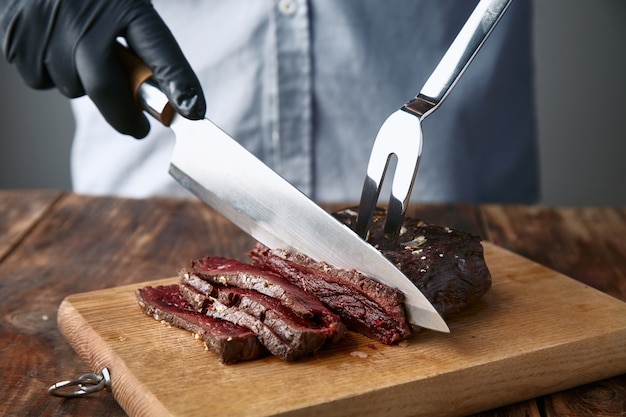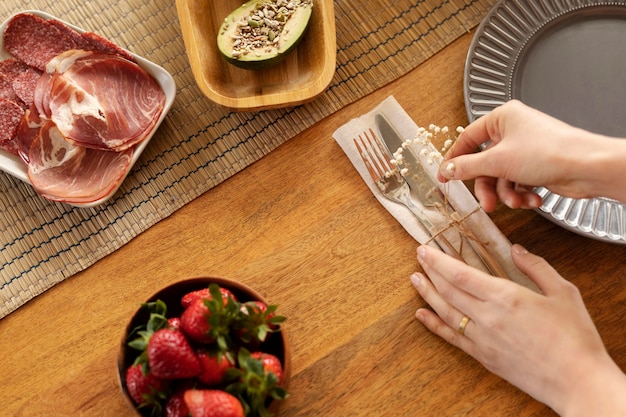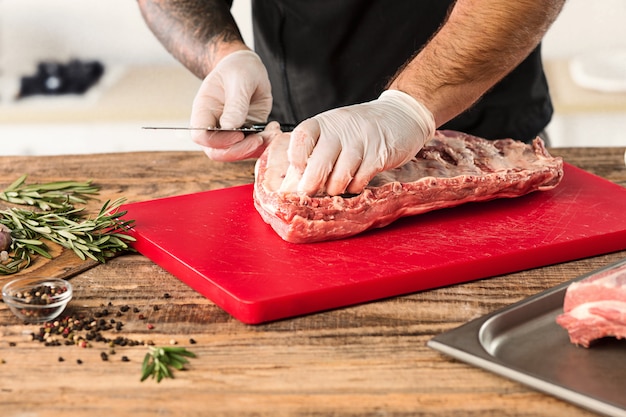There's a certain magic that happens when you bite into a perfectly cooked wagyu steak. That melt-in-your-mouth tenderness, the symphony of rich, buttery flavours – it's a culinary experience that leaves you wanting more. I've been fortunate enough to indulge in Wagyu at some of the best restaurants, but there's something undeniably satisfying about mastering the art of cooking it at home. It's a journey of discovery, a chance to unlock the secrets of this incredible meat and create a truly memorable dining experience.
So, grab your favourite apron, sharpen your knives, and get ready to elevate your home cooking to new heights. Let's embark on this adventure together, exploring everything from choosing the perfect cut to mastering the art of searing, resting, and finishing touches. By the end of this guide, you'll be well on your way to achieving Wagyu steak perfection in your own kitchen.
Part 1: Unveiling the Magic of Wagyu

Before we dive into the cooking process, let's take a moment to appreciate the unique qualities of wagyu beef. It's not just any ordinary steak; it's a masterpiece of nature, meticulously nurtured and celebrated for its exceptional marbling and rich flavour. Wagyu cattle, originally from Japan, are renowned for their genetic predisposition to produce a higher percentage of intramuscular fat, giving the meat its signature buttery tenderness and exquisite taste.
Understanding the Wagyu Grading System
The marbling, or the intricate network of fat within the muscle, is the key to Wagyu's luxurious texture and flavour. To understand the quality of a Wagyu cut, you need to grasp the grading system. In Japan, the highest grade is A5, signifying exceptional marbling and a truly decadent eating experience. However, even lower grades like A4 or A3 can offer a delicious taste and melt-in-your-mouth texture.
When choosing your Wagyu, look for a cut that's well-marbled and has a rich, deep red colour. Avoid cuts that appear dry or pale, as these may have a lower fat content and won't be as tender or flavourful. Ask your butcher for recommendations based on your preference for marbling and cooking method.
Part 2: Choosing the Perfect Wagyu Cut for Home Cooking

The world of Wagyu cuts can feel overwhelming, but don't worry, I'm here to guide you through it. For home cooks, there are a few cuts that stand out as perfect choices for their ease of preparation and delicious flavour.
The Classics: Ribeye, strip loin, and Tenderloin
These three cuts are consistently popular for good reason. They boast excellent marbling and a tender texture that makes them a joy to cook and enjoy.
- Ribeye: Known for its rich flavour and generous marbling, ribeye is the quintessential Wagyu cut. It's best cooked medium-rare to medium, allowing the fat to render and create a succulent, melt-in-your-mouth experience.
- Strip Loin: A slightly leaner cut than ribeye, strip loin offers a balance of flavour and tenderness. It's perfect for grilling or pan-searing, resulting in a delicious steak with a beautiful crust.
- Tenderloin: The most tender of the three, tenderloin is prized for its delicate flavour. It's often served as filet mignon, making it a perfect choice for a special occasion.
Beyond the Classics: Exploring Other Cuts
If you're feeling adventurous, you can explore other Wagyu cuts like the chuck, flank, or skirt. These cuts might require a bit more preparation, but they offer unique textures and flavours that can elevate your culinary experience.
For instance, chuck can be used for braising, resulting in a melt-in-your-mouth stew. Flank and skirt are ideal for grilling or stir-frying, creating a chewy and flavourful texture.
Part 3: Bringing the Steak to Room Temperature: A Crucial Step

One of the most common mistakes home cooks make is cooking a steak straight from the refrigerator. This can lead to uneven cooking, a tough exterior, and a cold, raw centre. To avoid this, it's crucial to bring your Wagyu steak to room temperature before cooking.
Why Room Temperature Matters:
When a steak is cold, the outer layer cooks much faster than the inside, creating an uneven distribution of heat. This can result in a tough exterior and an undercooked interior. Bringing the steak to room temperature allows the heat to penetrate the meat more evenly, ensuring that the entire steak cooks to your desired doneness.
How Long to Let It Sit:
I generally recommend taking the steak out of the refrigerator 30-45 minutes before cooking. This gives the steak enough time to reach room temperature without spoiling. However, if you're short on time, you can always give it a quick 10-15 minute "warm up" on the counter.
Part 4: Seasoning the Steak: Simplicity is Key
Wagyu steak is known for its inherent flavour, so it doesn't need a lot of fancy seasoning to shine. In fact, sometimes, less is more. My philosophy is to let the natural flavours of the meat take centre stage while enhancing them with simple yet effective seasoning.
Salt and Pepper: A Classic Combination
A generous pinch of kosher salt and freshly ground black pepper is all you really need. The salt draws out moisture, creating a flavorful crust and sealing in the juices, while the pepper adds a touch of warmth and depth. Don't be afraid to use a generous amount of salt – it's essential for a delicious and satisfying steak.
Experimenting with Herbs and Spices
If you're looking to add a touch of complexity, consider incorporating herbs and spices. Rosemary, thyme, oregano, garlic powder, paprika, and even a sprinkle of chili flakes can add subtle notes of flavour. Just remember to use them sparingly, as you don't want to overpower the delicate taste of the Wagyu.
Marinades: A Bold Approach
For those who prefer a bolder flavour profile, a marinade can be a fantastic option. A simple soy sauce, olive oil, garlic, and ginger marinade can infuse the steak with umami richness. However, keep the marinating time short – no more than an hour – as excessive marinating can toughen the meat.
Part 5: Mastering the Art of Searing: The Foundation of a perfect steak
Searing is the key to achieving that irresistible, caramelized crust and locking in the steak's natural juices. It's a crucial step that transforms a simple steak into a culinary masterpiece.
The Equipment: Cast Iron for a perfect sear
For the best results, I highly recommend using a cast iron skillet. Its heavy base distributes heat evenly, while its porous surface promotes excellent browning. The heat retention of cast iron allows you to achieve a truly scorching sear, creating a beautiful crust and sealing in the juices.
Getting the Skillet Smoking Hot
Heat your skillet over high heat until it's smoking hot. This is a critical step that ensures a proper sear. Add a tablespoon of oil to the hot skillet, swirling it around to coat the bottom evenly.
The Technique: Searing with Precision
Once the oil is shimmering, carefully place the steak in the skillet. Don't overcrowd the pan – you want to ensure that the steak has enough space to sear properly.
Searing time varies depending on the thickness of the steak and your desired level of doneness. As a general guideline, sear each side for:
- Thin steak (less than 1 inch): 1-2 minutes per side.
- Medium steak (1-1.5 inches): 2-3 minutes per side.
- Thick steak (over 1.5 inches): 3-4 minutes per side.
Resist the urge to press down on the steak. This will only release juices and prevent a proper sear. Use tongs to carefully flip the steak, ensuring even browning on all sides.
Part 6: The Crucial Role of Resting: Letting the Steak Relax
Once your steak is seared to perfection, don't rush to slice into it. Allowing it to rest for 5-10 minutes is essential for a juicy and tender final product.
The Science Behind Resting:
During cooking, the steak's juices are forced towards the centre. If you cut into the steak immediately, these juices will flow out, leaving you with a dry and disappointing result. Resting allows the juices to redistribute evenly throughout the meat, resulting in a more tender, succulent, and flavorful steak.
Resting Techniques:
You can rest the steak on a cutting board, covered with foil, or on a wire rack. The latter is particularly beneficial as it allows air to circulate around the steak, preventing it from steaming in its own juices.
Part 7: The Ultimate Guide to Doneness: Finding Your Perfect Level
Doneness is a matter of personal preference, but Wagyu steak truly shines in the medium-rare to medium range. This allows the marbling to melt and render, creating a luxurious texture and a symphony of flavours.
Doneness Guide:
| Doneness | internal temperature (Fahrenheit) | Internal Temperature (Celsius) | Appearance |
|---|---|---|---|
| Rare | 125-130°F | 52-54°C | Cool red centre |
| Medium-Rare | 130-135°F | 54-57°C | Warm red centre |
| Medium | 135-140°F | 57-60°C | Pink centre |
| Medium-Well | 140-145°F | 60-63°C | Slightly pink centre |
| Well-Done | 145-150°F | 63-66°C | No pink centre |
Using a meat thermometer for Precision
For the most accurate results, I highly recommend using a meat thermometer. Insert it into the thickest part of the steak, avoiding the bone. Ensure the thermometer is positioned in the centre and not touching the pan.
Part 8: Finishing Touches: Elevating Your Wagyu Steak
The finishing touches are what transform a good steak into an extraordinary one. From simple yet effective additions to elegant sauces, there are many ways to elevate your Wagyu steak.
The Magic of Butter:
A pat of unsalted butter placed on the resting steak will melt and infuse the meat with rich flavour and moisture. The butter will also create a beautiful, glossy finish that's both visually appealing and delicious.
Sauces to Enhance the Flavour:
A simple sauce can add another layer of complexity to your Wagyu steak. Here are some classic choices that complement the richness of the meat beautifully:
- Béarnaise sauce: A creamy, tangy sauce made with egg yolks, butter, vinegar, and herbs. It's a perfect match for the richness of Wagyu, providing a delightful contrast of flavours.
- Red wine sauce: A rich and savory sauce made with red wine, shallots, garlic, and herbs. It complements the flavour of the steak beautifully, adding depth and complexity to the overall experience.
- Mushroom sauce: A delicious and earthy sauce made with mushrooms, butter, and herbs. It's an excellent choice for Wagyu steak, adding a touch of umami and a satisfyingly rich texture.
Part 9: side dishes to Complement Your Masterpiece
No Wagyu steak is complete without a selection of carefully chosen side dishes. These should complement the richness of the steak without overwhelming its flavour.
Roasted Vegetables: A Touch of Colour and Texture
Roasted vegetables like Brussel sprouts, asparagus, or root vegetables bring a lovely contrast of colour and texture to your Wagyu steak. Season them with herbs and spices to create a flavourful accompaniment that balances the richness of the meat.
potato gratin: A Creamy and Decadent Side
Potato gratin is a creamy and decadent side dish that complements the flavour of Wagyu steak perfectly. Its rich, cheesy flavour and creamy texture create a luxurious experience.
Green Salad: A Refreshing Counterpoint
A simple green salad with a light vinaigrette provides a refreshing counterpoint to the richness of the steak. The crisp, clean flavours of the salad cleanse the palate, preparing you for another bite of the delicious Wagyu.
Part 10: FAQs: Answers to Your Burning Questions
Here are some common questions about cooking Wagyu steak at home, along with my expert answers.
1. How do I know if Wagyu is real?
Unfortunately, there's no foolproof way to tell if you're getting real Wagyu without checking the label. Look for "Japanese Wagyu" or "Australian Wagyu" and a marbling score. Reputable butchers and online retailers should be able to provide you with this information. If you're unsure, don't hesitate to ask your butcher for clarification.
2. Can I cook Wagyu from frozen?
It's best to cook Wagyu steak from fresh, as this will ensure the most tender and flavorful result. However, if you need to use frozen steak, defrost it slowly in the refrigerator. This will help to prevent the steak from becoming tough. Never defrost steak at room temperature, as this can encourage bacteria growth.
3. What happens if I overcook Wagyu steak?
Overcooked Wagyu steak will be tough and dry. The marbling will render out, and the flavour will be muted. Aim for medium-rare to medium for the best results. If you're unsure, use a meat thermometer to ensure your steak is cooked to your desired level of doneness.
4. Can I use any skillet to sear Wagyu?
While a cast iron skillet is the best choice for searing Wagyu due to its heat retention and browning capabilities, you can also use a stainless steel skillet or a nonstick pan if you have to. Just make sure the pan is heated over high heat to achieve a proper sear.
5. How long can I store leftover Wagyu steak?
Store leftover Wagyu steak in an airtight container in the refrigerator for up to 3 days. You can reheat it in the oven, microwave, or skillet until it is heated through.
I hope this guide has provided you with all the tools and inspiration you need to achieve Wagyu steak perfection at home. Remember, cooking Wagyu is a journey of exploration and discovery. Don't be afraid to experiment with different cuts, seasonings, and cooking methods. Most importantly, enjoy the process and the delicious results of your culinary adventure!
Everyone is watching

How to Cook Frozen Lobster Tails Perfectly: A Step-by-Step Guide
RecipesLobster. Just the word conjures up images of lavish meals, special occasions, and a taste of luxury. But let's...

Pigs in a Blanket Cooking Time: How Long to Bake for Perfect Results
RecipesAh, pigs in a blanket. Just the name conjures up images of those delightful little parcels of crispy pastry en...

Pork Fillet Cooking Time: How Long to Cook It Perfectly
RecipesPork fillet, or tenderloin as it's sometimes called, is a real favourite in our house. It's so versatile, and...

The Ultimate Guide to Tender, Juicy Pulled Pork
RecipesRight, let's talk pulled pork. It's one of those dishes that just screams "comfort food," doesn't it? I mean...

The Ultimate Guide to Cooking Sweet Potatoes: From Roasting to Mashing
RecipesSweet potatoes. Just the name conjures up images of warm, comforting dishes, bursts of vibrant color, and a to...
